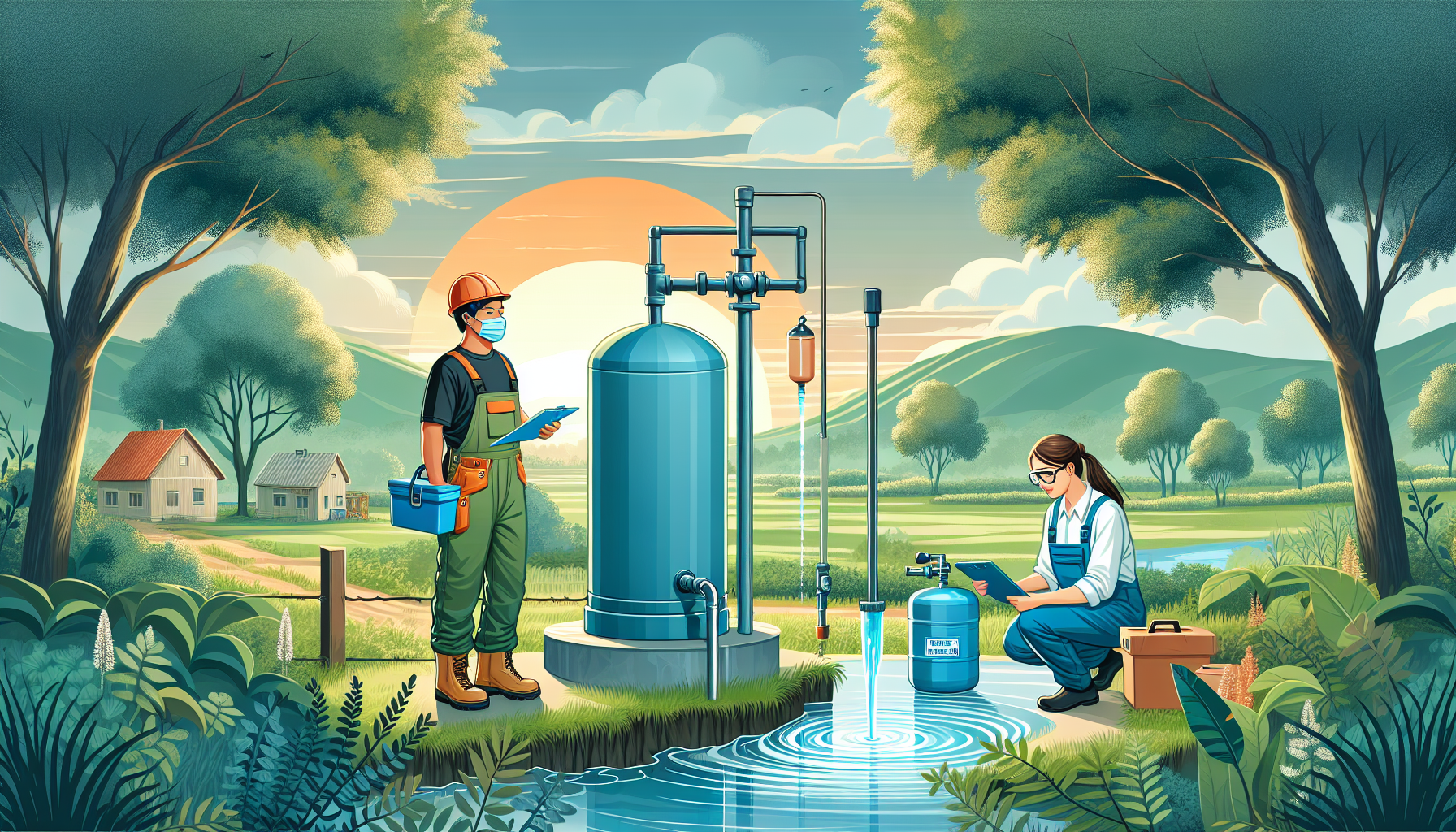If you rely on well water in an area where pressure tank replacement schedules are in place, ensuring the safety of your water supply becomes a vital concern. Understanding the importance of maintaining a well-functioning pressure tank system is the first step towards keeping your well water safe. In this article, we will explore methods and precautions you can take to ensure the continued safety of your well water, even in regions with established replacement schedules for pressure tanks. So let’s dive in and discover how you can maintain your water supply in top-notch condition.
Understanding Well Water Pressure Tanks
What is a well water pressure tank?
A well water pressure tank is an essential component of a well water system. It is a cylindrical tank that stores water and pressurizes it for household use. The tank is usually made of steel or fiberglass and is equipped with a bladder or diaphragm that separates the water from the air inside the tank. This separation allows for the creation of pressure, which ensures a steady flow of water throughout your home.
How does a well water pressure tank function?
The operation of a well water pressure tank is relatively simple. When the well pump fills the tank with water, the air inside the tank compresses, creating pressure. As you open a faucet or turn on an appliance, water is released from the tank, relieving the pressure and causing the pump to kick in and refill the tank. This cycle of pressure buildup and release ensures a consistent water supply and helps protect the pump from excessive wear.
What is the purpose of a well water pressure tank?
The primary purpose of a well water pressure tank is to regulate and maintain optimal water pressure for your household needs. It serves as a buffer between the well pump and the plumbing system, ensuring a constant pressure regardless of the pump’s cycling on and off. Additionally, the pressure tank aids in reducing the pump’s frequency of operation, which can prolong its lifespan and contribute to energy efficiency.
Why are well water pressure tanks replaced?
Well water pressure tanks typically have a long lifespan, but they will eventually need to be replaced due to wear and tear, age, or damage. Over time, the bladder or diaphragm inside the tank may fail, causing pressure issues or waterlogging. Corrosion can also occur, especially in metal tanks, leading to leaks or reduced performance. Regular inspections and maintenance can help identify these problems early on and prevent more significant issues.
What is a well water pressure tank replacement schedule?
The replacement schedule for well water pressure tanks can vary depending on factors such as the tank’s quality, usage, and water conditions. As a general guideline, it is recommended to have the pressure tank inspected annually. If any issues are found, replacement may be necessary sooner. On average, well water pressure tanks can last between 10 to 25 years. A professional well water expert can provide guidance on the specific replacement schedule for your region and water system.
Importance of Well Water Safety
Why is well water safety important?
Ensuring well water safety is crucial for maintaining the health and well-being of everyone relying on the water supply. Unlike public water sources, well water is not subject to the same regulatory oversight. Therefore, it is the responsibility of well owners to take proactive measures to ensure the water’s purity. Contaminated well water can pose various health risks, ranging from mild gastrointestinal issues to severe bacterial or chemical poisoning. Additionally, healthy water is vital for drinking, cooking, bathing, and other daily activities.
Common contaminants found in well water
There are various potential contaminants that may be present in well water. These can include bacteria such as E. coli or coliform, which may indicate fecal contamination. Chemical contaminants like pesticides, heavy metals, and volatile organic compounds can also find their way into well water. Nitrates from fertilizers or septic systems and naturally occurring minerals like arsenic and radon can pose risks as well. It is essential to be aware of the specific contaminants that are more prevalent in your region to address them effectively.
Health risks associated with contaminated well water
Contaminated well water can have serious health consequences. Bacterial contamination can cause gastrointestinal illnesses, leading to diarrhea, vomiting, and abdominal pain. Chemical contaminants like pesticides or heavy metals can have long-term effects on neurological, reproductive, or respiratory systems. Nitrates, especially harmful to infants and pregnant women, can result in methemoglobinemia, also known as “blue baby syndrome.” It is vital to identify and eliminate these risks to safeguard the health of your family.

Factors to Consider for Well Water Safety
Knowledge of well water pressure tank replacement schedule
Being aware of your well water pressure tank’s replacement schedule is crucial for maintaining water safety. A faulty or deteriorating pressure tank can lead to water quality issues and disruptions in water flow. By adhering to the recommended replacement schedule and promptly addressing any problems, you can ensure a consistently reliable supply of clean water.
Identifying potential contaminants
Regular water testing and inspection can help identify potential contaminants in your well water. By understanding the specific risks associated with your region, such as agricultural runoff or industrial pollution, you can take appropriate measures to prevent or treat the presence of these contaminants. It is important to keep up-to-date with the latest research and local advisories to stay informed about potential threats.
Maintaining well water quality
Maintaining well water quality is essential for ensuring safety. This includes preventing surface water contamination through proper well construction, regular maintenance, and regular testing. Additionally, keeping the area around the well clean and free from potential pollutants can help maintain good water quality. Regular well inspections and maintenance, along with keeping records of the water system’s history, will aid in promptly addressing any issues that arise.
Proper well and septic system maintenance
Regular maintenance of both the well and septic system is crucial for overall water safety. Ensuring that the well casing is intact, the wellhead is secure, and the seals are in good condition helps prevent potential contamination. Septic system maintenance, such as regular pumping and inspections, is essential to avoid any cross-contamination between well water and sewage. A well-maintained septic system reduces the risk of microbial contamination and protects water quality.
Regular water testing and inspection
Regular water testing and inspection are fundamental to ensuring well water safety. Testing should include comprehensive analysis for bacteria, chemical contaminants, and other potential risks. The frequency of testing may depend on factors such as the region, well construction, proximity to potential contaminants, and any previous issues with water quality. Engaging the services of a professional water testing laboratory can provide accurate and reliable results, helping you make informed decisions about the safety of your water.
Ensuring Well Water Safety in Regions with Replacement Schedules
Be aware of the replacement schedule
In regions with well water pressure tank replacement schedules, it is crucial to be aware of the recommended timeline for replacing your pressure tank. By following the schedule, you can proactively address any potential issues and avoid the risk of water contamination or system failure. Regularly communicate with local well water experts or health departments to stay informed about any updates or changes to the replacement schedule.
Inspect the pressure tank regularly
Regular inspections of the pressure tank are essential for identifying any signs of wear, damage, or malfunction. Look for visible signs of corrosion, leaks, or abnormalities in pressure. Check the tank’s connecting pipes, valves, and fittings for any signs of deterioration or loose connections. If you notice any issues during the inspection, contact a professional well water expert to assess the situation and determine if replacement or repairs are necessary.
Monitor water pressure and flow
Monitoring water pressure and flow is another important aspect of maintaining well water safety. Keep an eye on fluctuations in water pressure, slow flow rates, or an inability to maintain consistent pressure. These issues may indicate a problem with the pressure tank or the well system as a whole. If you notice any significant changes, consult a well water expert to diagnose and address the underlying cause promptly.
Maintain a clean well and proper septic system
Maintaining a clean well and septic system is crucial for well water safety. Regularly inspect the well surroundings to ensure that there are no potential sources of contamination, such as chemicals, animal waste, or debris, in close proximity. Keep the wellhead area clean and free from vegetation to prevent surface water from entering the well. Proper maintenance of the septic system, including routine inspections and pumping, will prevent any cross-contamination between sewage and well water.
Test water quality regularly
Regularly testing the water quality is vital for ensuring well water safety in regions with replacement schedules. Proper testing can identify any bacterial, chemical, or mineral contaminants present in the water. Follow the recommended testing frequency and ensure that the testing includes a comprehensive analysis of the water’s composition. Consulting with a professional water testing laboratory and understanding the interpretation of the results will help you determine if any corrective actions are required.
Implement water treatment measures
Water treatment measures can be effective in ensuring well water safety. Depending on the contaminants present, various treatment options are available, such as filtration systems, disinfection methods, or water softeners. Choose a treatment system that targets the specific contaminants identified in your water testing. Regularly maintain and replace the treatment systems as recommended by the manufacturer to ensure their optimal performance.
Consider additional water safety precautions
In regions with replacement schedules, it may be necessary to consider additional water safety precautions. These can include installing a back-up power source for the well pump in case of power outages, implementing regular maintenance routines, and ensuring proper well construction. Educate yourself and your family about water safety measures, such as avoiding cross-contamination between well water and potential contaminants. By taking these extra precautions, you can enhance well water safety and protect the health of your household.

Water Testing and Inspection
Types of water tests to consider
When it comes to ensuring well water safety, several types of water tests are worth considering. These tests can provide valuable information about the presence of different contaminants and the overall quality of the water. Common types of water tests include testing for bacteria such as E. coli or coliform, testing for chemical contaminants, including pesticides, heavy metals, or volatile organic compounds, and testing for minerals like nitrates, arsenic, or radon. Conducting a comprehensive water analysis will help determine any necessary treatment methods or potential risks associated with the water supply.
Frequency of water testing
The frequency of water testing can vary depending on several factors, including regional regulations, well construction, and previous test results. As a general guideline, it is recommended to test the well water at least once a year for bacteria and basic water chemistry. However, testing may need to occur more frequently in specific circumstances, such as if there are changes in the water quality or if nearby contamination sources are identified. Regular testing is essential for proactive monitoring of water quality and to ensure the ongoing safety of your well water.
Importance of professional water testing
Professional water testing is essential for accurate and reliable results. While at-home water testing kits may provide some basic information, they do not always capture the full scope of potential contaminants. Professional laboratories have the necessary expertise and equipment to conduct comprehensive analysis that covers a wide range of contaminants in various concentrations. By relying on professionals, you can have confidence in the accuracy of the results and make informed decisions regarding the safety and treatment of your well water.
Interpreting water testing results
Interpreting water testing results can sometimes be complex, especially when multiple contaminants are detected. It is recommended to consult with a water testing professional or a well water expert to understand the implications of the results fully. They can help you assess the risks associated with specific contaminants, provide guidance on treatment options, and define any necessary preventive or corrective actions. By seeking expert advice, you can ensure that the water testing results are appropriately understood and addressed.
Water Treatment Measures
Types of water treatment systems
There are various types of water treatment systems available to address different contaminants found in well water. Some common types of water treatment systems include activated carbon filters, reverse osmosis systems, ultraviolet (UV) disinfection, and water softeners. Each system targets specific contaminants or water quality issues. Choosing the appropriate water treatment system based on the detected contaminants and the desired water quality goals is crucial for effective purification.
Choosing the right water treatment system
Selecting the right water treatment system requires careful consideration of the contaminants present in the well water. It is essential to understand the specific removal capabilities of each treatment system and how well they address the identified contaminants. Consulting with a professional water treatment expert can help determine the most suitable system for your needs and ensure proper installation and maintenance.
Maintaining and replacing water treatment systems
Regular maintenance and periodic replacement of water treatment systems are necessary for maintaining their effectiveness. Follow the manufacturer’s recommendations for routine maintenance tasks such as cleaning, filter replacement, or disinfection. Additionally, monitor the system’s performance over time and be alert for any changes in water quality or treatment efficacy. When the treatment system reaches the end of its lifespan, replace it promptly to ensure continuous well water safety.
Water treatment alternatives
In addition to traditional water treatment systems, there are alternative approaches to consider. For example, point-of-use water filters can be installed on faucets or at the point of entry to treat specific water outlets or the entire household supply. These filters can remove contaminants such as lead, chlorine, or sediment. Other alternatives include distillation systems or solar water disinfection methods. Research and consult with water treatment experts to explore alternative options and determine the most appropriate solution for your well water safety needs.

Additional Safety Precautions
Installing a backup power source
Installing a backup power source for the well pump is a wise precaution in regions with well water pressure tank replacement schedules. Power outages can disrupt water flow, especially if they occur during the replacement of the pressure tank. A backup generator or battery-powered system can help ensure a continuous water supply during such events and maintain well water safety.
Implementing regular maintenance
Regular maintenance is essential for preventing issues that may compromise well water safety. Develop a maintenance routine that includes regular inspections, cleaning, and servicing of the well system components. Follow the manufacturer’s recommendations for the maintenance of pressure tanks, well pumps, and any other relevant equipment. Promptly address any identified issues to prevent further deterioration and maintain the overall efficiency and safety of the well water system.
Ensuring proper well construction
Proper well construction is critical to prevent surface water contamination and maintain well water safety for regions with well water pressure tank replacement schedules. Ensure that the well is constructed according to local regulations and standards. Key considerations include proper casing, sealing, and insulation to prevent the entry of contaminants. Consulting with well drilling professionals or experienced well contractors will help ensure the well is constructed correctly and in compliance with the necessary guidelines.
Preventing surface water contamination
Preventing surface water contamination is crucial for maintaining well water safety. Regularly inspect the area surrounding the well to identify potential sources of contamination, such as fertilizers, pesticides, or animal waste. Keep the area around the well clear of debris, ensure proper drainage, and consider implementing protective measures, such as installing a secure well cap or fencing to restrict access. By preventing surface water from entering the well, you can minimize the risk of contamination.
Educating yourself and your family
Education is key to ensuring well water safety. Take the time to educate yourself and your family about the potential risks, preventive measures, and maintenance practices related to well water. Teach everyone in your household about proper water usage, cross-contamination prevention, and the importance of regular water testing. By empowering yourself and your family with knowledge, you can actively contribute to the ongoing safety and protection of your well water supply.
Consulting Professionals
Importance of professional guidance
Consulting professionals regarding well water safety is crucial for obtaining accurate information and expert advice. Professionals who specialize in well water systems and water quality can provide valuable insights into regional regulations, well construction guidelines, maintenance practices, and treatment options. Their expertise helps ensure that you make informed decisions regarding the safety and maintenance of your well water system.
Seeking assistance from well water experts
Well water experts can provide specialized knowledge and guidance specific to your region and well water system. If you have concerns about your well water or are uncertain about the appropriate safety measures, consider reaching out to a well water expert. They can assess your specific situation, suggest effective strategies for maintaining water safety, and answer any questions you may have. Well water experts can also perform inspections, recommend treatment systems, and provide ongoing support to ensure the long-term safety of your well water.
Engaging with local health departments
Local health departments can serve as valuable resources for understanding regional regulations, receiving guidance, and accessing necessary information regarding well water safety. They can provide recommendations for water testing laboratories, connect you with expertise on well construction standards, and advise on potential threats or contaminants in your area. Engaging with your local health department will help ensure that you have access to the current and accurate information needed to maintain well water safety.

Local Regulations and Guidelines
Understanding regional regulations
Each region may have specific regulations and guidelines in place for well water safety. These regulations may cover aspects such as well construction standards, water testing requirements, or maintenance practices. It is essential to familiarize yourself with the local regulations to ensure compliance and to implement the necessary safety measures for your well water system. Local health departments or well water experts can provide you with the most up-to-date information on regional regulations.
Following well water guidelines
Alongside regional regulations, there are often recommended guidelines for maintaining well water safety. These guidelines may include water testing frequency, suggested maintenance routines, and best practices for preventing contamination. Adhering to these guidelines will help you establish a comprehensive approach to well water safety and reduce the risk of potential health hazards. Stay informed about any updates to the guidelines and incorporate the recommended practices into your well water management routine.
Conclusion
Prioritizing well water safety is essential for the health and well-being of everyone relying on a well water system. Understanding well water pressure tanks, the purpose they serve, and the importance of their maintenance is crucial. Additionally, recognizing the significance of well water safety, the common contaminants that can be found, and the health risks associated with them is paramount.
In regions with well water pressure tank replacement schedules, it is important to be knowledgeable about the schedule and adhere to it. Regular inspections and maintenance should be conducted to identify potential issues and address them promptly. Being proactive in ensuring well water quality, proper well and septic system maintenance, regular water testing, and implementing water treatment measures are essential aspects of maintaining well water safety.
Incorporating additional safety precautions, such as installing a backup power source, practicing regular maintenance, ensuring proper well construction, preventing surface water contamination, and educating yourself and your family, further enhances well water safety. Consulting professionals, seeking assistance from well water experts, and engaging with local health departments can provide valuable guidance and expertise in maintaining the safety of your well water system.
By understanding the local regulations and following the guidelines, you can ensure compliance and implement the necessary measures for well water safety. Regular checks, inspections, and maintenance practices will help to safeguard the health of everyone relying on your well water system. Prioritizing well water safety, remaining vigilant, and taking appropriate actions will ensure a continuous supply of clean and safe well water for your household.


